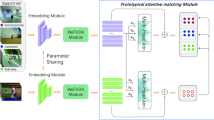Abstract
In this paper, we develop a novel method to design a robust feature representation based on deep convolutional features and Latent Dirichlet Allocation (LDA) model for human action recognition. Compared to traditional CNN features which explore the outputs from the fully connected layers in CNN, we show that a low dimension feature representation generated on the deep convolutional layers is more discriminative. In addition, based on the convolutional feature maps, we use a multi-scale pooling strategy to better handle the objects with different scales and deformations. Moreover, we adopt LDA to explore the semantic relationship in video sequences and generate a topic histogram to represent a video, since LDA puts more emphasis on the content coherence than mere spatial contiguity. Extensive experimental results on two challenging datasets show that the proposed approach outperforms or is competitive with state-of-the-art methods for the application of human action recognition.
Access this chapter
Tax calculation will be finalised at checkout
Purchases are for personal use only
Similar content being viewed by others
References
Liu, P., Wang, J., She, M., et al.: Human action recognition based on 3D SIFT and LDA model. In: Robotic Intelligence in Informationally Structured Space, pp. 12–17. IEEE (2011)
Niebles, J.C., Wang, H., Fei-Fei, L.: Unsupervised learning of human action categories using spatial-temporal words. Int. J. Comput. Vis. 79(3), 299–318 (2008)
Wang, H., et al.: Evaluation of local spatio-temporal features for action recognition. In: British Machine Vision Conference (BMVC 2009), London, 7–10 September 2009. Proceedings DBLP (2009)
Le, Q.V., Zou, W.Y., Yeung, S.Y., et al.: Learning hierarchical invariant spatio-temporal features for action recognition with independent subspace analysis. In: Computer Vision and Pattern Recognition, pp. 3361–3368. IEEE Xplore (2011)
Rodriguez, M.D, Ahmed, J., Shah, M.: Action MACH a spatio-temporal maximum average correlation height filter for action recognition. In: IEEE Conference on Computer Vision and Pattern Recognition (CVPR 2008), pp. 1–8. IEEE (2008)
Liu, J., Luo, J., Shah, M.: Recognizing realistic actions from videos “in the wild”. In: IEEE Computer Society Conference on Computer Vision and Pattern Recognition, pp. 1996–2003. DBLP (2009)
Hasan, M., Roy-Chowdhury, A.K.: Incremental activity modeling and recognition in streaming videos. In: Computer Vision and Pattern Recognition, pp. 796–803. IEEE (2014)
Kovashka, A., Grauman, K.: Learning a hierarchy of discriminative space-time neighborhood features for human action recognition. In: Computer Vision and Pattern Recognition, pp. 2046–2053. IEEE (2010)
Laptev, L.: Space-time interest points. In: International Conference on Computer Vision, vol. 1, pp. 432–439. IEEE Xplore (2003)
Dollar, P., Rabaud, V., Cottrell, G., et al.: Behavior recognition via sparse spatio-temporal features. In: Joint IEEE International Workshop on Visual Surveillance and Performance Evaluation of Tracking and Surveillance, pp. 65–72. IEEE (2005)
Guo, Y., Lao, S., Liu, Y., Bai, L., Liu, S., Lew, M.S.: Convolutional neural networks features: principal pyramidal convolution. In: Ho, Y.-S., Sang, J., Ro, Y.M., Kim, J., Wu, F. (eds.) PCM 2015. LNCS, vol. 9314, pp. 245–253. Springer, Cham (2015). https://doi.org/10.1007/978-3-319-24075-6_24
Yosinski, J., Clune, J., Bengio, Y., et al.: How transferable are features in deep neural networks? Eprint Arxiv arXiv:1411.1792, vol. 27, pp. 3320–3328 (2014)
Hofmann, T.: Probabilistic latent semantic indexing. In: International ACM SIGIR Conference on Research and Development in Information Retrieval, pp. 50–57. ACM (1999)
Blei, D.M., Ng, A.Y., Jordan, M.I.: Latent Dirichlet allocation. J. Mach. Learn. Res. 3, 993–1022 (2003)
Chong, W., Blei, D., Li, F.F.: Simultaneous image classification and annotation. In: IEEE Conference on Computer Vision and Pattern Recognition (CVPR 2009), pp. 1903–1910. IEEE (2009)
Cao, L., Li, F.F.: Spatially coherent latent topic model for concurrent segmentation and classification of objects and scenes. In: IEEE International Conference on Computer Vision, pp. 1–8. DBLP (2007)
Chang, C.C., Lin, C.J.: LIBSVM: a library for support vector machines. ACM Trans. Intell. Syst. Technol. (TIST) 2(3), 1–27 (2011)
Simonyan, K., Zisserman, A.: Very deep convolutional networks for large-scale image recognition. Computer Science (2014)
He, K., et al.: Spatial pyramid pooling in deep convolutional networks for visual recognition. IEEE Trans. Pattern Anal. Mach. Intell. 37(9), 1904–1916 (2015)
Krizhevsky, A., Sutskever, I., Hinton, G.E.: ImageNet classification with deep convolutional neural networks. In: International Conference on Neural Information Processing Systems Curran Associates Inc., pp. 1097–1105 (2012)
Szegedy, C., Liu, W., Jia, Y., et al.: Going deeper with convolutions, pp. 1–9 (2014)
He, K., et al.: Deep residual learning for image recognition. In: Computer Vision and Pattern Recognition, pp. 770–778. IEEE (2015)
Souly, N., Shah, M.: Visual saliency detection using group lasso regularization in videos of natural scenes. Int. J. Comput. Vis. 117(1), 93–110 (2016)
Wang, H., Klaser, A., Schmid, C., et al.: Action recognition by dense trajectories. In: IEEE Conference on Computer Vision and Pattern Recognition, pp. 3169–3176. IEEE Computer Society (2011)
Ikizler-Cinbis, N., Sclaroff, S.: Object, scene and actions: combining multiple features for human action recognition. In: Daniilidis, K., Maragos, P., Paragios, N. (eds.) ECCV 2010. LNCS, vol. 6311, pp. 494–507. Springer, Heidelberg (2010). https://doi.org/10.1007/978-3-642-15549-9_36
Author information
Authors and Affiliations
Corresponding author
Editor information
Editors and Affiliations
Rights and permissions
Copyright information
© 2018 Springer International Publishing AG, part of Springer Nature
About this paper
Cite this paper
Zhou, Y., Pu, N., Qian, L., Wu, S., Xiao, G. (2018). Human Action Recognition in Videos of Realistic Scenes Based on Multi-scale CNN Feature. In: Zeng, B., Huang, Q., El Saddik, A., Li, H., Jiang, S., Fan, X. (eds) Advances in Multimedia Information Processing – PCM 2017. PCM 2017. Lecture Notes in Computer Science(), vol 10736. Springer, Cham. https://doi.org/10.1007/978-3-319-77383-4_31
Download citation
DOI: https://doi.org/10.1007/978-3-319-77383-4_31
Published:
Publisher Name: Springer, Cham
Print ISBN: 978-3-319-77382-7
Online ISBN: 978-3-319-77383-4
eBook Packages: Computer ScienceComputer Science (R0)




